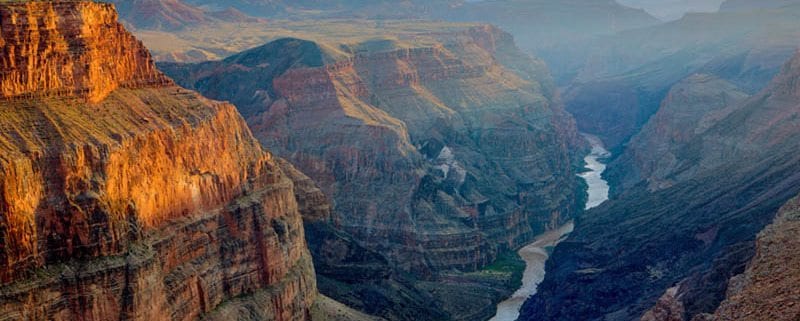Grand Canyon Things to Do | Advanced Hiking Tips
If you are in good physical condition and want to experience a unique Grand Canyon adventure, embark on a rim-to-rim hike.
Approximately 25 miles long, the hike is challenging, but it offers adventure-seekers a plethora of memorable views you can’t see from a vehicle.
If you would like to tackle the rim-to-rim hike, careful planning is important. Determining how to get back to your car is a key question to answer – before you start your trip.
The North and South Rims are around 10 miles apart as a bird flies but approximately 25 miles apart as the hiker walks. However, when you traverse the path by road, it requires a 220 miles drive that can take as long as five and a half hours.
What are your options? Well, you can attempt a round trip hike, venturing from one rim to the other, and back. If you try this, careful planning is especially crucial.
An easier choice is using public transportation to access one rim from the other. Two alternatives are Grand Canyon Coaches (928-638-0281) or the Trans-Canyon Shuttle (928-638-2820).
The North Kaibab Trail is the only maintained trail into the canyon from the north rim. This trail is 14 miles long that begins at the head of Roaring Springs Canyon and ends at Bright Angel Campground and the Colorado River.
To connect the South Rim to the inner canyon, rim-to-rim hikers must either venture along the Bright Angel Trail or the South Kaibab Trail.
There is no water available along the South Kaibab Trail, which can only be reached by the free Grand Canyon National Park shuttle bus, is located off Yaki Point Road, which is closed to private vehicles.
On the Bright Angel Trail, Indian Gardens provides water and a campsite just 4.5 miles below the South Rim.
When determining whether to hike from the South Rim to the North Rim, or vice versa, consider that a north to south hike requires a shorter climb out of the canyon. The North Kaibab trail head is at about 8200 feet. The South Kaibab trailhead is located at approximately 7,200 feet while the Bright Angel trailhead is around 6,800 feet.
Another factor to consider is that the North Rim is closed from mid-November to mid-May. Arizona 67, which serves as the road into the North Rim, is closed from the first major snowfall (which usually happens in mid-November) through the spring thaw (which typically occurs in mid-May. North Rim facilities are also closed during this period.
Also, since the inner canyon is scorching hot, it is best to avoid a rim-to-rim hike in June, July and August.
Be sure to give yourself at least three days and two nights to complete a rim-to-rim hike. This is not a day trip.
To learn more about the Grand Canyon itself, make plans to see the Visitor Center (www.explorethecanyon.com), which is located at the south rim entrance of Grand Canyon National Park. The visitor center serves as a destination and a resource for the most comprehensive selection of information about Grand Canyon area hotels, tours, attractions, restaurants and sightseeing and outdoor activities.
The Visitor Center features a 500-seat IMAX Theater which shows “Grand Canyon: Rivers of Time,” a 2,500-square-foot outfitter store, exhibits and maps, and national park interpretive services and park passes. The facility also includes a 140-seat restaurant, Expeditions sightseeing tours and the Arizona Office of Tourism.
Grand Canyon: Rivers of Time is a perfect way to begin your Grand Canyon vacation because the film introduces viewers to the natural wonders and riveting history that lies within the canyon. The movie is shown hourly, 365 days a year. Seen by more than 40 million people since its debut 20 years ago, Grand Canyon is the highest-grossing giant-screen film of all time.



